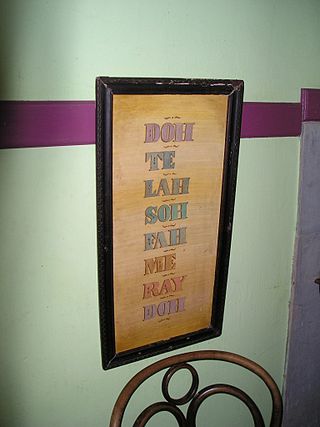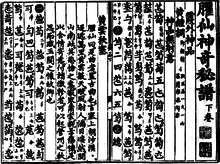
Figured bass is musical notation in which numerals and symbols appear above or below a bass note. The numerals and symbols indicate intervals, chords, and non-chord tones that a musician playing piano, harpsichord, organ, or lute should play in relation to the bass note. Figured bass is closely associated with basso continuo: a historically improvised accompaniment used in almost all genres of music in the Baroque period of Classical music, though rarely in modern music. Figured bass is also known as thoroughbass.

In music, just intonation or pure intonation is the tuning of musical intervals as whole number ratios of frequencies. An interval tuned in this way is said to be pure, and is called a just interval. Just intervals consist of tones from a single harmonic series of an implied fundamental. For example, in the diagram, if the notes G3 and C4 are tuned as members of the harmonic series of the lowest C, their frequencies will be 3 and 4 times the fundamental frequency. The interval ratio between C4 and G3 is therefore 4:3, a just fourth.

In Western musical notation, a key signature is a set of sharp, flat, or rarely, natural symbols placed on the staff at the beginning of a section of music. The initial key signature in a piece is placed immediately after the clef at the beginning of the first line. If the piece contains a section in a different key, the new key signature is placed at the beginning of that section.

Musical notation is any system used to visually represent auditorily perceived music, played with instruments or sung by the human voice through the use of symbols, including notation for durations of absence of sound such as rests. For this reason, the act of deciphering or reading a piece using musical notation, is known as "reading music".
In music, notes are distinct and isolatable sounds that act as the most basic building blocks for nearly all of music. This discretization facilitates performance, comprehension, and analysis. Notes may be visually communicated by writing them in musical notation.
In music, an octave or perfect octave is a series of eight notes occupying the interval between two notes, one having twice the frequency of vibration of the other. The octave relationship is a natural phenomenon that has been referred to as the "basic miracle of music", the use of which is "common in most musical systems". The interval between the first and second harmonics of the harmonic series is an octave. In Western music notation, notes separated by an octave have the same name and are of the same pitch class.
In musical notation, an accidental is a symbol that indicates an alteration of a given pitch. The most common accidentals are the flat and the sharp, which represent alterations of a semitone, and the natural, which cancels a sharp or flat. Accidentals alter the pitch of individual scale tones in a given key signature; the sharps or flats in the key signature itself are not considered accidentals.

A clef is a musical symbol used to indicate which notes are represented by the lines and spaces on a musical staff. Placing a clef on a staff assigns a particular pitch to one of the five lines or four spaces, which defines the pitches on the remaining lines and spaces.
In music, two written notes have enharmonic equivalence if they produce the same pitch but are notated differently. Similarly, written intervals, chords, or key signatures are considered enharmonic if they represent identical pitches that are notated differently. The term derives from Latin enharmonicus, in turn from Late Latin enarmonius, from Ancient Greek ἐναρμόνιος, from ἐν ('in') and ἁρμονία ('harmony').

In music, a chord is a group of two or more notes played simultaneously, typically consisting of a root note, a third, and a fifth. Chords are the building blocks of harmony and form the harmonic foundation of a piece of music. They can be major, minor, diminished, augmented, or extended, depending on the intervals between the notes and their arrangement. Chords provide the harmonic support and coloration that accompany melodies and contribute to the overall sound and mood of a musical composition. For many practical and theoretical purposes, arpeggios and other types of broken chords may also be considered as chords in the right musical context.
In music, a pitch class (p.c. or pc) is a set of all pitches that are a whole number of octaves apart; for example, the pitch class C consists of the Cs in all octaves. "The pitch class C stands for all possible Cs, in whatever octave position." Important to musical set theory, a pitch class is "all pitches related to each other by octave, enharmonic equivalence, or both." Thus, using scientific pitch notation, the pitch class "C" is the set

Braille music is a braille code that allows music to be notated using braille cells so music can be read by visually impaired musicians. The system was incepted by Louis Braille.

The guqin is a plucked seven-string Chinese musical instrument. It has been played since ancient times, and has traditionally been favoured by scholars and literati as an instrument of great subtlety and refinement, as highlighted by the quote "a gentleman does not part with his qin or se without good reason," as well as being associated with the ancient Chinese philosopher Confucius. It is sometimes referred to by the Chinese as "the father of Chinese music" or "the instrument of the sages". The guqin is not to be confused with the guzheng, another Chinese long stringed instrument also without frets, but with moveable bridges under each string.
The numbered musical notation is a cipher notation system used in Mainland China, Taiwan, Hong Kong, and to some extent in Japan, Indonesia, Malaysia, Australia, Ireland, the United Kingdom, the United States and English-speaking Canada. It dates back to the system designed by Pierre Galin, known as Galin-Paris-Chevé system. It is also known as Ziffernsystem, meaning "number system" or "cipher system" in German.
Gongche notation or gongchepu is a traditional musical notation method, once popular in ancient China. It uses Chinese characters to represent musical notes. It was named after two of the Chinese characters that were used to represent musical notes, namely "工" gōng and "尺" chě.
Notation plays a relatively minor role in the oral traditions of Indonesian gamelan but, in Java and Bali, several systems of gamelan notation were devised beginning at the end of the 19th century, initially for archival purposes.
The notation of the guqin is a unique form of tablature for the Chinese musical instrument, with a history of over 1,500 years, still in use today.

Tonic sol-fa is a pedagogical technique for teaching sight-singing, invented by Sarah Ann Glover (1785–1867) of Norwich, England and popularised by John Curwen, who adapted it from a number of earlier musical systems. It uses a system of musical notation based on movable do solfège, whereby every note is given a name according to its relationship with other notes in the key: the usual staff notation is replaced with anglicized solfège syllables or their abbreviations. "Do" is chosen to be the tonic of whatever key is being used. The original solfège sequence started with "Ut", the first syllable of the hymn Ut queant laxis, which later became "Do".
The Nashville Number System is a method of transcribing music by denoting the scale degree on which a chord is built. It was developed by Neal Matthews Jr in the late 1950s as a simplified system for the Jordanaires to use in the studio and further developed by Charlie McCoy. It resembles the Roman numeral and figured bass systems traditionally used to transcribe a chord progression since the 1700s. The Nashville Number System was compiled and published in a book by Chas. Williams in 1988.
The Nashville Number System is a trick that musicians use to figure out chord progressions on the fly. It is an easy tool to use if you understand how music works. It has been around for about four hundred years, but sometime during the past fifty years [approximately 1953–2003], Nashville got the credit.
The Nashville numbering system provided us the shorthand that we needed so that we could depend on our ears rather than a written arrangement. It took far less time to jot the chords, and once you had the chart written, it applied to any key. The beauty of the system is that we don't have to read. We don't get locked into an arrangement that we may feel is not as good as one we can improvise.










